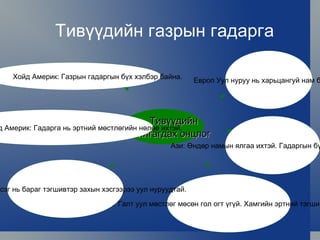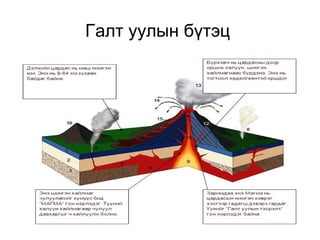1 of 8
Downloaded 19 times








Ad
Recommended
–ľ–ĺ–Ĺ–≥–ĺ–Ľ –ĺ—Ä–Ĺ—č –≥–į–ī–į—Ä–≥—č–Ĺ —É—Ā, –≥–ĺ–Ľ –ľ”©—Ä–ī 8—Ä –į–Ĺ–≥–ł —Ö–į–Ĺ–ī–ľ–į–į
–ľ–ĺ–Ĺ–≥–ĺ–Ľ –ĺ—Ä–Ĺ—č –≥–į–ī–į—Ä–≥—č–Ĺ —É—Ā, –≥–ĺ–Ľ –ľ”©—Ä–ī 8—Ä –į–Ĺ–≥–ł —Ö–į–Ĺ–ī–ľ–į–įkhandmaa79
Őż
–ī—ć–Ľ—Ö–ł–Ļ–Ĺ –ī–į–Ľ–į–Ļ –Ī–į —Ö—É—É—Ä–į–Ļ –≥–į–∑–į—Ä
–ī—ć–Ľ—Ö–ł–Ļ–Ĺ –ī–į–Ľ–į–Ļ –Ī–į —Ö—É—É—Ä–į–Ļ –≥–į–∑–į—ÄAmarjargal Amaraa
Őż
—Ö—ć–Ĺ –Ĺ—ć–≥—ć–Ĺ–ī —Ö—ć—Ä—ć–≥ –Ī–ĺ–Ľ–∂ –ľ–į–≥–į–ī7 r angi gazarzvi usan mandln bvreldehvvn
7 r angi gazarzvi usan mandln bvreldehvvnzulzagatsogoo
Őż
–£—Ā–į–Ĺ –ľ–į–Ĺ–ī–Ľ—č–Ĺ –Ī“Į—Ä—ć–Ľ–ī—ć—Ö“Į“Į–Ĺ–ł–Ļ —ā–į–Ľ–į–į—Ä Validation practical definition
Validation practical definitionJohan Hoberg
Őż
Validation is the process of ensuring a product or service meets requirements and will consistently perform as expected in actual use. It involves testing a product or service against requirements, analyzing the test results, and documenting whether the requirements are met. Validation activities help identify risks and ensure quality criteria are addressed.The Uncertainty Principle
The Uncertainty PrincipleJeremy Coates
Őż
1. The document discusses the uncertainty principle and how it is impossible to know both the precise position and momentum of a particle at the same time.
2. It argues that software development is a learning process where uncertainty decreases over time as knowledge increases. Early decisions should not dominate later development when understanding is greatest.
3. The key ideas are that uncertainty should be used as an indicator to consider options and defer commitment, and that the best way to achieve flexibility is to understand specific examples rather than trying to account for all possible general cases. –ė–Ě–Ę–ē–ď–†–ź–õ –Ę–ź–õ–Ď–ź–ô /Integral/
–ė–Ě–Ę–ē–ď–†–ź–õ –Ę–ź–õ–Ď–ź–ô /Integral/Khishighuu Myanganbuu
Őż
–Ē–ĺ–ļ—É–ľ–Ķ–Ĺ—ā –ĺ–Ī—Ā—É–∂–ī–į–Ķ—ā –ľ–Ķ—ā–ĺ–ī—č —á–ł—Ā–Ľ–Ķ–Ĺ–Ĺ–ĺ–≥–ĺ –ł–Ĺ—ā–Ķ–≥—Ä–ł—Ä–ĺ–≤–į–Ĺ–ł—Ź –ł –ĺ–Ņ—ā–ł–ľ–ł–∑–į—Ü–ł–ł, –≤–ļ–Ľ—é—á–į—Ź –≤—č—á–ł—Ā–Ľ–Ķ–Ĺ–ł–Ķ –Ņ–Ľ–ĺ—Č–į–ī–ł –Ņ–ĺ–ī –ļ—Ä–ł–≤–ĺ–Ļ –ł –Ĺ–į—Ö–ĺ–∂–ī–Ķ–Ĺ–ł–Ķ –Ľ–ĺ–ļ–į–Ľ—Ć–Ĺ—č—Ö –ł –≥–Ľ–ĺ–Ī–į–Ľ—Ć–Ĺ—č—Ö –ľ–ł–Ĺ–ł–ľ—É–ľ–ĺ–≤ —Ą—É–Ĺ–ļ—Ü–ł–Ļ. –ü—Ä–ł–≤–ĺ–ī—Ź—ā—Ā—Ź –Ņ—Ä–ł–ľ–Ķ—Ä—č –į–Ľ–≥–ĺ—Ä–ł—ā–ľ–ĺ–≤, —ā–į–ļ–ł—Ö –ļ–į–ļ –ľ–Ķ—ā–ĺ–ī —Ā–∂–į—ā–ł—Ź –ł–Ĺ—ā–Ķ—Ä–≤–į–Ľ–į –ł ¬ę–Ņ–ĺ—á—ā–ł –Ņ–ĺ–Ľ–ĺ–≤–ł–Ĺ–Ĺ–ĺ–≥–嬼 –ī–Ķ–Ľ–Ķ–Ĺ–ł—Ź. –ě–Ī—Ā—É–∂–ī–į—é—ā—Ā—Ź –Ņ—Ä–ĺ–Ī–Ľ–Ķ–ľ—č, —Ā–≤—Ź–∑–į–Ĺ–Ĺ—č–Ķ —Ā –≤—č–Ī–ĺ—Ä–ĺ–ľ –Ĺ–į—á–į–Ľ—Ć–Ĺ–ĺ–Ļ —ā–ĺ—á–ļ–ł –ł –Ĺ–į—Ö–ĺ–ī–ļ–ĺ–Ļ –≥–Ľ–ĺ–Ī–į–Ľ—Ć–Ĺ–ĺ–≥–ĺ –ľ–ł–Ĺ–ł–ľ—É–ľ–į.Social cognitive perspective
Social cognitive perspectivesherrymariani
Őż
The social-cognitive perspective views personality as emerging from the interaction between personal factors, behavior, and environmental influences. Albert Bandura's social cognitive theory proposes that behavior results from reciprocal determinism, where a person's behavior both influences and is influenced by personal factors and the social environment. Social-cognitive psychologists study behavior in realistic and simulated situations as the best way to understand and predict how people will act in similar contexts.More Related Content
What's hot (16)
–ī—ć–Ľ—Ö–ł–Ļ–Ĺ –ī–į–Ľ–į–Ļ –Ī–į —Ö—É—É—Ä–į–Ļ –≥–į–∑–į—Ä
–ī—ć–Ľ—Ö–ł–Ļ–Ĺ –ī–į–Ľ–į–Ļ –Ī–į —Ö—É—É—Ä–į–Ļ –≥–į–∑–į—ÄAmarjargal Amaraa
Őż
—Ö—ć–Ĺ –Ĺ—ć–≥—ć–Ĺ–ī —Ö—ć—Ä—ć–≥ –Ī–ĺ–Ľ–∂ –ľ–į–≥–į–ī7 r angi gazarzvi usan mandln bvreldehvvn
7 r angi gazarzvi usan mandln bvreldehvvnzulzagatsogoo
Őż
–£—Ā–į–Ĺ –ľ–į–Ĺ–ī–Ľ—č–Ĺ –Ī“Į—Ä—ć–Ľ–ī—ć—Ö“Į“Į–Ĺ–ł–Ļ —ā–į–Ľ–į–į—Ä Viewers also liked (10)
Validation practical definition
Validation practical definitionJohan Hoberg
Őż
Validation is the process of ensuring a product or service meets requirements and will consistently perform as expected in actual use. It involves testing a product or service against requirements, analyzing the test results, and documenting whether the requirements are met. Validation activities help identify risks and ensure quality criteria are addressed.The Uncertainty Principle
The Uncertainty PrincipleJeremy Coates
Őż
1. The document discusses the uncertainty principle and how it is impossible to know both the precise position and momentum of a particle at the same time.
2. It argues that software development is a learning process where uncertainty decreases over time as knowledge increases. Early decisions should not dominate later development when understanding is greatest.
3. The key ideas are that uncertainty should be used as an indicator to consider options and defer commitment, and that the best way to achieve flexibility is to understand specific examples rather than trying to account for all possible general cases. –ė–Ě–Ę–ē–ď–†–ź–õ –Ę–ź–õ–Ď–ź–ô /Integral/
–ė–Ě–Ę–ē–ď–†–ź–õ –Ę–ź–õ–Ď–ź–ô /Integral/Khishighuu Myanganbuu
Őż
–Ē–ĺ–ļ—É–ľ–Ķ–Ĺ—ā –ĺ–Ī—Ā—É–∂–ī–į–Ķ—ā –ľ–Ķ—ā–ĺ–ī—č —á–ł—Ā–Ľ–Ķ–Ĺ–Ĺ–ĺ–≥–ĺ –ł–Ĺ—ā–Ķ–≥—Ä–ł—Ä–ĺ–≤–į–Ĺ–ł—Ź –ł –ĺ–Ņ—ā–ł–ľ–ł–∑–į—Ü–ł–ł, –≤–ļ–Ľ—é—á–į—Ź –≤—č—á–ł—Ā–Ľ–Ķ–Ĺ–ł–Ķ –Ņ–Ľ–ĺ—Č–į–ī–ł –Ņ–ĺ–ī –ļ—Ä–ł–≤–ĺ–Ļ –ł –Ĺ–į—Ö–ĺ–∂–ī–Ķ–Ĺ–ł–Ķ –Ľ–ĺ–ļ–į–Ľ—Ć–Ĺ—č—Ö –ł –≥–Ľ–ĺ–Ī–į–Ľ—Ć–Ĺ—č—Ö –ľ–ł–Ĺ–ł–ľ—É–ľ–ĺ–≤ —Ą—É–Ĺ–ļ—Ü–ł–Ļ. –ü—Ä–ł–≤–ĺ–ī—Ź—ā—Ā—Ź –Ņ—Ä–ł–ľ–Ķ—Ä—č –į–Ľ–≥–ĺ—Ä–ł—ā–ľ–ĺ–≤, —ā–į–ļ–ł—Ö –ļ–į–ļ –ľ–Ķ—ā–ĺ–ī —Ā–∂–į—ā–ł—Ź –ł–Ĺ—ā–Ķ—Ä–≤–į–Ľ–į –ł ¬ę–Ņ–ĺ—á—ā–ł –Ņ–ĺ–Ľ–ĺ–≤–ł–Ĺ–Ĺ–ĺ–≥–嬼 –ī–Ķ–Ľ–Ķ–Ĺ–ł—Ź. –ě–Ī—Ā—É–∂–ī–į—é—ā—Ā—Ź –Ņ—Ä–ĺ–Ī–Ľ–Ķ–ľ—č, —Ā–≤—Ź–∑–į–Ĺ–Ĺ—č–Ķ —Ā –≤—č–Ī–ĺ—Ä–ĺ–ľ –Ĺ–į—á–į–Ľ—Ć–Ĺ–ĺ–Ļ —ā–ĺ—á–ļ–ł –ł –Ĺ–į—Ö–ĺ–ī–ļ–ĺ–Ļ –≥–Ľ–ĺ–Ī–į–Ľ—Ć–Ĺ–ĺ–≥–ĺ –ľ–ł–Ĺ–ł–ľ—É–ľ–į.Social cognitive perspective
Social cognitive perspectivesherrymariani
Őż
The social-cognitive perspective views personality as emerging from the interaction between personal factors, behavior, and environmental influences. Albert Bandura's social cognitive theory proposes that behavior results from reciprocal determinism, where a person's behavior both influences and is influenced by personal factors and the social environment. Social-cognitive psychologists study behavior in realistic and simulated situations as the best way to understand and predict how people will act in similar contexts.–ú–Ķ–Ĺ–Ķ–∂–ľ–Ķ–Ĺ—ā–ł–Ļ–Ĺ –ĺ–Ĺ–ĺ–Ľ, –ĺ–Ĺ–ĺ–Ľ—č–Ĺ “Į“Į—Ā—ć–Ľ, —Ö”©–≥–∂–ł–Ľ, –ú–ĺ–Ĺ–≥–ĺ–Ľ –ĺ–Ĺ–ĺ–Ľ ...
–ú–Ķ–Ĺ–Ķ–∂–ľ–Ķ–Ĺ—ā–ł–Ļ–Ĺ –ĺ–Ĺ–ĺ–Ľ, –ĺ–Ĺ–ĺ–Ľ—č–Ĺ “Į“Į—Ā—ć–Ľ, —Ö”©–≥–∂–ł–Ľ, –ú–ĺ–Ĺ–≥–ĺ–Ľ –ĺ–Ĺ–ĺ–Ľ ...Adilbishiin Gelegjamts
Őż
–ú–Ķ–Ĺ–Ķ–∂–ľ–Ķ–Ĺ—ā–ł–Ļ–Ĺ –ĺ–Ĺ–ĺ–Ľ—č–Ĺ “Į“Į—Ā—ć–Ľ, —Ö”©–≥–∂–ł–Ľ, –ú–ĺ–Ĺ–≥–ĺ–Ľ –ĺ–Ĺ–ĺ–Ľ ...Designing Teams for Emerging Challenges
Designing Teams for Emerging ChallengesAaron Irizarry
Őż
The document discusses designing teams and processes to adapt to changing needs. It recommends structuring teams so members can work within their competencies and across projects fluidly with clear roles and expectations. The design process should support the team and their work, and be flexible enough to change with team, organization, and project needs. An effective team culture builds an environment where members feel free to be themselves, voice opinions, and feel supported.3 Things Every Sales Team Needs to Be Thinking About in 2017
3 Things Every Sales Team Needs to Be Thinking About in 2017Drift
Őż
Sales teams in 2017 need to update their strategies by incorporating messaging into their outreach, fixing outdated BDR processes to engage buyers in real-time, and enhancing account-based marketing to provide personalized experiences. The document emphasizes integrating messaging tools like live chat into existing setups to better connect with prospects. Additionally, it highlights the importance of responding to leads in a timely manner and treating them as individuals rather than forcing traditional form-filling mechanisms.–ú–Ķ–Ĺ–Ķ–∂–ľ–Ķ–Ĺ—ā–ł–Ļ–Ĺ –ĺ–Ĺ–ĺ–Ľ, –ĺ–Ĺ–ĺ–Ľ—č–Ĺ “Į“Į—Ā—ć–Ľ, —Ö”©–≥–∂–ł–Ľ, –ú–ĺ–Ĺ–≥–ĺ–Ľ –ĺ–Ĺ–ĺ–Ľ ...
–ú–Ķ–Ĺ–Ķ–∂–ľ–Ķ–Ĺ—ā–ł–Ļ–Ĺ –ĺ–Ĺ–ĺ–Ľ, –ĺ–Ĺ–ĺ–Ľ—č–Ĺ “Į“Į—Ā—ć–Ľ, —Ö”©–≥–∂–ł–Ľ, –ú–ĺ–Ĺ–≥–ĺ–Ľ –ĺ–Ĺ–ĺ–Ľ ...Adilbishiin Gelegjamts
Őż
Ad
Similar to —Ö—ć—Ä—ć–≥–Ľ—ć–≥–ī—ć—Ö“Į“Į–Ĺ (20)
–ď–į–∑–į—Ä–∑“Į–Ļ 7. 3.2 –Ē—ć–Ľ—Ö–ł–Ļ–Ĺ –≥–į–ī–į—Ä–≥—č–Ĺ —Ö—ć–Ľ–Ī—ć—Ä...pdf
–ď–į–∑–į—Ä–∑“Į–Ļ 7. 3.2 –Ē—ć–Ľ—Ö–ł–Ļ–Ĺ –≥–į–ī–į—Ä–≥—č–Ĺ —Ö—ć–Ľ–Ī—ć—Ä...pdfEnkh Tseba
Őż
–ď–į–∑–į—Ä–∑“Į–Ļ 7 –Ē—ć–Ľ—Ö–ł–Ļ–Ĺ –≥–į–ī–į—Ä–≥—č–Ĺ —Ö—ć–Ľ–Ī—ć—Ä–ď–į–∑–į—Ä–∑“Į–Ļ 7. 3-—Ä –Ī“Į–Ľ—ć–≥ –Ē—ć–Ľ—Ö–ł–Ļ–Ĺ –≥–į–ī–į—Ä–≥–į.pdf
–ď–į–∑–į—Ä–∑“Į–Ļ 7. 3-—Ä –Ī“Į–Ľ—ć–≥ –Ē—ć–Ľ—Ö–ł–Ļ–Ĺ –≥–į–ī–į—Ä–≥–į.pdfEnkh Tseba
Őż
–ď–į–∑–į—Ä–∑“Į–Ļ 7 –Ē—ć–Ľ—Ö–ł–Ļ–Ĺ –≥–į–ī–į—Ä–≥–į–ď–į–∑–į—Ä–∑“Į–Ļ 7-—Ä –į–Ĺ–≥–ł 3-—Ä –Ī“Į–Ľ—ć–≥ "–Ē—ć–Ľ—Ö–ł–Ļ–Ĺ –≥–į–ī–į—Ä–≥–į"
–ď–į–∑–į—Ä–∑“Į–Ļ 7-—Ä –į–Ĺ–≥–ł 3-—Ä –Ī“Į–Ľ—ć–≥ "–Ē—ć–Ľ—Ö–ł–Ļ–Ĺ –≥–į–ī–į—Ä–≥–į"Enkh Tseba
Őż
–Ē—ć–Ľ—Ö–ł–Ļ–Ĺ –≥–į–ī–į—Ä–≥–į –ď–į–∑–į—Ä–∑“Į–Ļ 8 –ú–ĺ–Ĺ–≥–ĺ–Ľ –ĺ—Ä–Ĺ—č –Ī–į–Ļ–≥–į–Ľ–ł–Ļ–Ĺ —ā”©—Ä—Ö.ppt
–ď–į–∑–į—Ä–∑“Į–Ļ 8 –ú–ĺ–Ĺ–≥–ĺ–Ľ –ĺ—Ä–Ĺ—č –Ī–į–Ļ–≥–į–Ľ–ł–Ļ–Ĺ —ā”©—Ä—Ö.pptEnkh Tseba
Őż
–Ď–į–Ļ–≥–į–Ľ–ł–Ļ–Ĺ —ā”©—Ä—Ö –Ī–į–Ļ–ī–į–Ľ Ad
—Ö—ć—Ä—ć–≥–Ľ—ć–≥–ī—ć—Ö“Į“Į–Ĺ
- 1. –Ę–ł–≤“Į“Į–ī–ł–Ļ–Ĺ –≥–į–∑—Ä—č–Ĺ –≥–į–ī–į—Ä–≥–į –Ę–ł–≤“Į“Į–ī–ł–Ļ–Ĺ —Ź–Ľ–≥–į–≥–ī–į—Ö –ĺ–Ĺ—Ü–Ľ–ĺ–≥ –ē–≤—Ä–ĺ–Ņ –£—É–Ľ –Ĺ—É—Ä—É—É –Ĺ—Ć —Ö–į—Ä—Ć—Ü–į–Ĺ–≥—É–Ļ –Ĺ–į–ľ –Ī–į–Ļ–ī–į–≥ . –ź–∑–ł: ”®–Ĺ–ī”©—Ä –Ĺ–į–ľ—č–Ĺ —Ź–Ľ–≥–į–į –ł—Ö—ā—ć–Ļ. –ď–į–ī–į—Ä–≥—č–Ĺ –Ī“Į—Ö —Ö—ć–Ľ–Ī—ć—Ä –Ī–į–Ļ–Ĺ –į. –ź–≤—Ā—ā—Ä–į–Ľ–ł: –ď–į–Ľ—ā —É—É–Ľ –ľ”©—Ā—ā–Ľ”©–≥ –ľ”©—Ā”©–Ĺ –≥–ĺ–Ľ –ĺ–≥—ā “Į–≥“Į–Ļ. –•–į–ľ–≥–ł–Ļ–Ĺ —ć—Ä—ā–Ĺ–ł–Ļ —ā—ć–≥—ą–ł–≤—ā—ć—Ä –≥–į–ī–į—Ä–≥–į—ā–į–Ļ . –ź—Ą—Ä–ł–ļ: –ė—Ö—ć–Ĺ—Ö —Ö—ć—Ā—ć–≥ –Ĺ—Ć –Ī–į—Ä–į–≥ —ā—ć–≥—ą–ł–≤—ā—ć—Ä –∑–į—Ö—č–Ĺ —Ö—ć—Ā–≥—ć—ć—Ä—ć—ć —É—É–Ľ –Ĺ—É—Ä—É—É–ī—ā–į –Ļ. ”®–ľ–Ĺ”©–ī –ź–ľ–Ķ—Ä–ł–ļ: –ď–į–ī–į—Ä–≥–į –Ĺ—Ć —ć—Ä—ā–Ĺ–ł–Ļ –ľ”©—Ā—ā–Ľ”©–≥–ł–Ļ–Ĺ –Ĺ”©–Ľ”©”© –ł—Ö—ā—ć–Ļ . –•–ĺ–Ļ–ī –ź–ľ–Ķ—Ä–ł–ļ: –ď–į–∑—Ä—č–Ĺ –≥–į–ī–į—Ä–≥—č–Ĺ –Ī“Į—Ö —Ö—ć–Ľ–Ī—ć—Ä –Ī–į–Ļ–Ĺ–į .
- 2. –Ę—ć–Ĺ–≥–ł—Ā: –£—Ā –∑“Į–Ļ–Ĺ –Ī–ĺ–Ľ–ĺ–Ĺ —É—É—Ä –į–ľ—Ć—Ā–≥–į–Ľ—č–Ĺ –≥–ĺ—Ä–ł–ľ–ĺ–ĺ—Ä–ĺ–ĺ –∑–į–ī–≥–į–Ļ –ī–į–Ľ–į–Ļ–≥–į–į—Ā —Ź–Ľ–≥–į–į—ā–į–Ļ –ī–į–Ľ–į–Ļ–Ĺ —É—Ā–Ĺ—č —Ö—ć—Ā—ć–≥ . –Ę—ć–Ĺ–≥–ł—Ā–ł–Ļ–≥ –ó–į—Ö—č–Ĺ —ā—ć–Ĺ–≥–ł—Ā |—ć—Ö –≥–į–∑—Ä—č–Ĺ —Ö–į—Ź–į–≥–į–į—Ä –ĺ—Ä—ą–ł–Ĺ–ĺ. –Ė –Ĺ—Ć: –•–ĺ–Ļ–ī —ā—ć–Ĺ–≥–ł—Ā, –®–į—Ä —ā—ć–Ĺ–≥–ł—Ā, –Į–Ņ–ĺ–Ĺ —ā—ć–Ĺ–≥–ł—Ā|
- 3. –ď–į–∑—Ä—č–Ĺ –ī—É–Ĺ–ī–į–ī —ā—ć–Ĺ–≥–ł—Ā |—ć—Ö –≥–į–∑—Ä—É—É–ī—č–Ĺ —Ö–ĺ–ĺ—Ä–ĺ–Ĺ–ī –ĺ—Ä—ą–ł—Ö –Ī–į –ī–į–Ľ–į–Ļ–≥–į–į—Ā –į–Ľ—Ā–Ľ–į–≥–ī—Ā–į–Ĺ. –Ė –Ĺ—Ć: –•–į—Ä —ā—ć–Ĺ–≥–ł—Ā, –ď–į–∑–į—Ä –ī—É–Ĺ–ī—č–Ĺ —ā—ć–Ĺ–≥–ł—Ā|
- 4. –Ē–ĺ—ā–ĺ–ĺ–ī—č–Ĺ —ā—ć–Ĺ–≥–ł—Ā –≥—ć–∂ –į–Ĺ–≥–ł–Ľ–Ĺ–į.|–≠—Ö –≥–į–∑—Ä—č–Ĺ –≥“Į–Ĺ —Ä“Į“Į –Ĺ–ł–Ľ—ć—ć–ī —ā“Į—Ä–∂ –ĺ—Ä—Ā–ĺ–Ĺ –ī–į–Ľ–į–Ļ–≥–į–į—Ā –ł—Ö —ā—É—Ā–≥–į–į—Ä–Ľ–į–≥–ī—Ā–į–Ĺ. –Ė –Ĺ—Ć: –ú—Ä–į–ľ–ĺ—Ä—č–Ĺ —ā—ć–Ĺ–≥–ł—Ā, –¶–į–≥–į–į–Ĺ —ā—ć–Ĺ–≥–ł—Ā, –Ď–į–Ľ—ā–ł–Ļ–Ĺ —ā—ć–Ĺ–≥–ł—Ā |
- 7. –ď–į–∑–į—Ä —Ö”©–ī–Ľ”©–Ľ—ā–ł–Ļ–Ĺ –ł–ī—ć–≤—Ö–ł—ā—ć–Ļ –Ī“Į—Ā“Į“Į–ī
- 8. –•–ĺ–Ĺ—Ö–ĺ—Ä —Ö–ĺ—ā–≥–ĺ—Ä –≥–į–∑–į—Ä —ā–ĺ–≥—ā—Ā–ĺ–Ĺ —É—Ā—č–≥ –Ĺ—É—É—Ä –≥—ć–Ĺ—ć . –Ě—É—É—Ä—É—É–ī –Ę–į–Ľ–Ī–į–Ļ –ļ–ľ –ļ–≤ –ě—Ä—ą–ł—Ö –≥–į–∑–į—Ä –£–≤—Ā 3350 –£–≤—Ā—č–Ĺ —Ö–ĺ—ā–≥–ĺ—Ä –•”©–≤—Ā–≥”©–Ľ 2760 –•”©–≤—Ā–≥”©–Ľ–ł–Ļ–Ĺ —É—É–Ľ–į–Ĺ–ī –•–į—Ä —É—Ā 1852 –ė—Ö –Ĺ—É—É—Ä—É—É–ī—č–Ĺ —Ö–ĺ—ā–≥–ĺ—Ä –•—Ź—Ä–≥–į—Ā 1407 –ė—Ö –Ĺ—É—É—Ä—É—É–ī—č–Ĺ —Ö–ĺ—ā–≥–ĺ—Ä –Ď—É–Ļ—Ä 615 –Ē–ĺ—Ä–Ĺ–ĺ–ī—č–Ĺ —ā–į–Ľ
- 9. –ú–į–Ĺ–į–Ļ –ĺ—Ä–ĺ–Ĺ–ī 262 –ľ”©—Ā—ā–Ľ”©–≥ –ľ”©—Ā”©–Ĺ –≥–ĺ–Ľ –Ĺ–ł–Ļ—ā 659 –į–ľ.–ļ–ľ —ā–į–Ľ–Ī–į–Ļ–≥ —ć–∑–Ľ—ć–Ĺ –ĺ—Ä—ą–ł–∂ –Ī–į–Ļ–Ĺ–į. –Ę—ć–ī–≥—ć—ć—Ä–ł–Ļ–Ĺ –ł—Ö—ć–Ĺ—Ö –Ĺ—Ć –ú–ĺ–Ĺ–≥–ĺ–Ľ –ź–Ľ—ā–į–Ļ–Ĺ –Ĺ—É—Ä—É—É–Ĺ–ī –Ī–į–Ļ–ī–į–≥. –•–į–ľ–≥–ł–Ļ–Ĺ —ā–ĺ–ľ –Ĺ—Ć –ü–ĺ—ā–į–Ĺ–ł–Ĺ—č –ľ”©—Ā”©–Ĺ –≥–ĺ–Ľ —é–ľ. –Ę“Į“Į–Ĺ–ł–Ļ —ā–į–Ľ–Ī–į–Ļ 53.3 –į–ľ.–ļ–ľ –ú”©—Ā”©–Ĺ –≥–ĺ–Ľ
- 10. –•–ĺ–Ĺ—Ö–ĺ—Ä –≥–į–∑—Ä—č–≥ –ī–į–≥–į–Ĺ –≥–ĺ–Ľ–ī–ł—Ä–Ľ–ĺ–ĺ—Ä —É—Ä—Ā–į–∂ –Ī—É–Ļ —É—Ā—č–≥ –≥–ĺ–Ľ –ľ”©—Ä”©–Ĺ –≥—ć–Ĺ—ć. –ď–ĺ–Ľ –ľ”©—Ä–ī –Ĺ—Ć —Ö—É—Ä –Ī–ĺ—Ä–ĺ–ĺ, —Ü–į—Ā, –ľ”©—Ā”©–Ĺ –≥–ĺ–Ľ, –≥–į–∑–į—Ä –ī–ĺ–ĺ—Ä—Ö —É—Ā–į–į—Ä —ā—ć–∂—ć—ć–≥–ī—ć–Ĺ—ć.
- 11. –Ę–ĺ–ľ –≥–ĺ–Ľ—č–≥ —Ü—É—ā–≥–į–Ľ—É—É–ī—č–Ĺ—Ö –Ĺ—Ć —Ö–į–ľ—ā –≥–ĺ–Ľ –ľ”©—Ä–Ĺ–ł–Ļ —Ā–ł—Ā—ā–Ķ–ľ –≥—ć–Ĺ—ć. –ď–ĺ–Ľ—č–Ĺ —Ā–ł—Ā—ā–Ķ–ľ–ī —Ö–į–ľ—Ä–į–≥–ī–į—Ö —ā–į–Ľ–Ī–į–Ļ–≥ –≥–ĺ–Ľ—č–Ĺ –į–Ļ —Ā–į–≤ –≥—ć–Ĺ—ć .